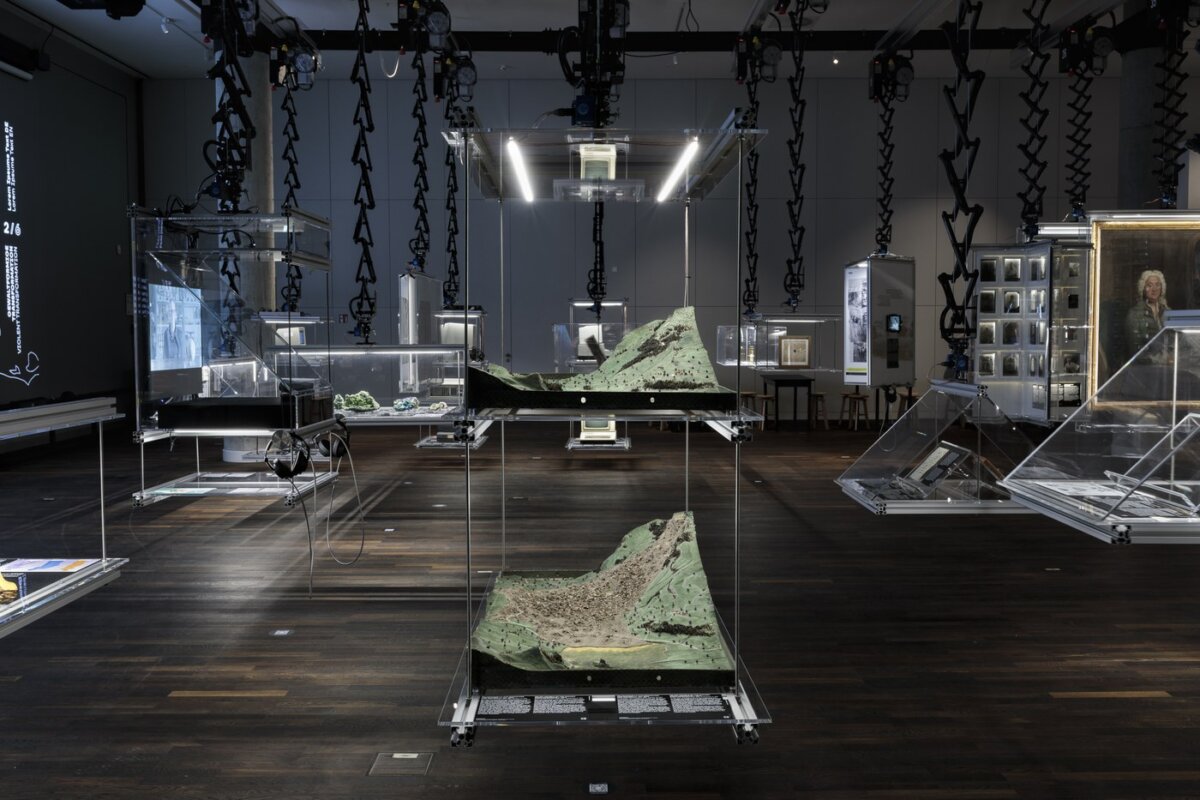With the audio exhibition ‘Zugetextet – Literatur als intermediale Praxis’, the Cluster of Excellence ‘Temporal Communities’ at Freie Universität opens up new perspectives on exhibition objects in the Humboldt Labor.
In 1806, masses of rock broke loose on the Rossberg and buried the Swiss village of Goldau under a metre-thick layer of rubble. This landslide was one of the worst natural disasters in Switzerland. A few years later, Joseph Martin Baumann, a tailor from Goldau, created two reliefs of the landslide, which are on display in the opening exhibition of the Humboldt Laboratory, to make it easier to understand what had happened.
These models, which are more than 200 years old, immediately fascinated Simon Godart. Together with other postdocs from the Cluster of Excellence ‘TEMPORAL COMMUNITIES: DOING LITERATURE IN A GLOBAL PERSPECTIVE’ at Freie Universität Berlin, Godart has developed audio contributions for the exhibition at the Humboldt Forum. The postdocs selected 15 exhibition objects or groups of objects that they found personally interesting and combined them with excerpts from literary texts and their own reflections.
Exhibition in the exhibition
The audio pieces forge links between objects in the collection and literary texts that, like the objects, come from different eras and political and cultural contexts. In this way, they connect visitors who come to the exhibition with their own background experiences with the world of thought of people from other contexts/lifeworlds. Dr Gorch Pieken, lead curator of the inaugural exhibition at the Humboldt Laboratory, describes ‘Zugetextet’ as an ‘invisible exhibition within the exhibition, through which the Cluster of Excellence opens up further access to the selected objects of meaning and reference.’
A literary quotation and an explanatory text that establishes a connection to the respective exhibit can be heard. ‘The quotation can complement the objects, counteract them or take them further. It’s always about a productive new perspective,’ says Dr Petra Wodtke, Scientific Coordinator of the Cluster of Excellence’s Berlin Partners Network. There is also a third part to some of the contributions: Conversations in which the researchers provide insights into their perspectives and the work process. ‘We wanted to make it clear that research always takes place in dialogue. And we wanted to give the researchers themselves, who often remain anonymous, a voice,’ explains Wodtke.
The postdocs have selected various objects for their audio exhibition, including the children’s Bible of a German sect in Chile, an empty bottle of Fairy Liquid or the cry for help of a textile worker from Bangladesh sewn into an item of clothing. Simon Godart was fascinated by the unknown when making his choice. ‘I was immediately drawn to exhibits that had something to do with mining and rocks. I found that exciting because I knew nothing about it,’ he explains. One of his contributions is dedicated to a so-called ‘Seigerriss’, a sectional drawing that makes the underground course of tunnels comprehensible. ‘If you know how to decipher such cracks,’ says Godart about what is still a “mysterious object” for him.
Another article is dedicated to the Swiss landslide. During his literature research, Simon Godart came across a book by the doctor Karl Zay entitled ‘Goldau und seine Gegend: Wie sie war und was sie geworden’ (1807), in which the event is described in detail. To Godart’s delight, the book begins with a quote from the poet Virgil. The author builds a bridge to antiquity in order to tie in his own train of thought. ‘This is proof of our theorem that literary temporalities make themselves felt – even where you wouldn’t expect them to,’ says the doctor of philosophy.
‘Zugetextet – Literatur als intermediale Praxis’ is not an audio tour in the traditional sense. The contributions have no predetermined order and are independent of the audio tour, which is embedded in an overview tour of all the exhibitions in the Humboldt Forum. The contributions from Temporal Communities bring to life what top researchers have to say about the objects in the collection, says Gorch Pieken. The audio tour is a ‘prime example’ of the so-called third mission to disseminate and popularise research and teaching far beyond the boundaries of the university.

